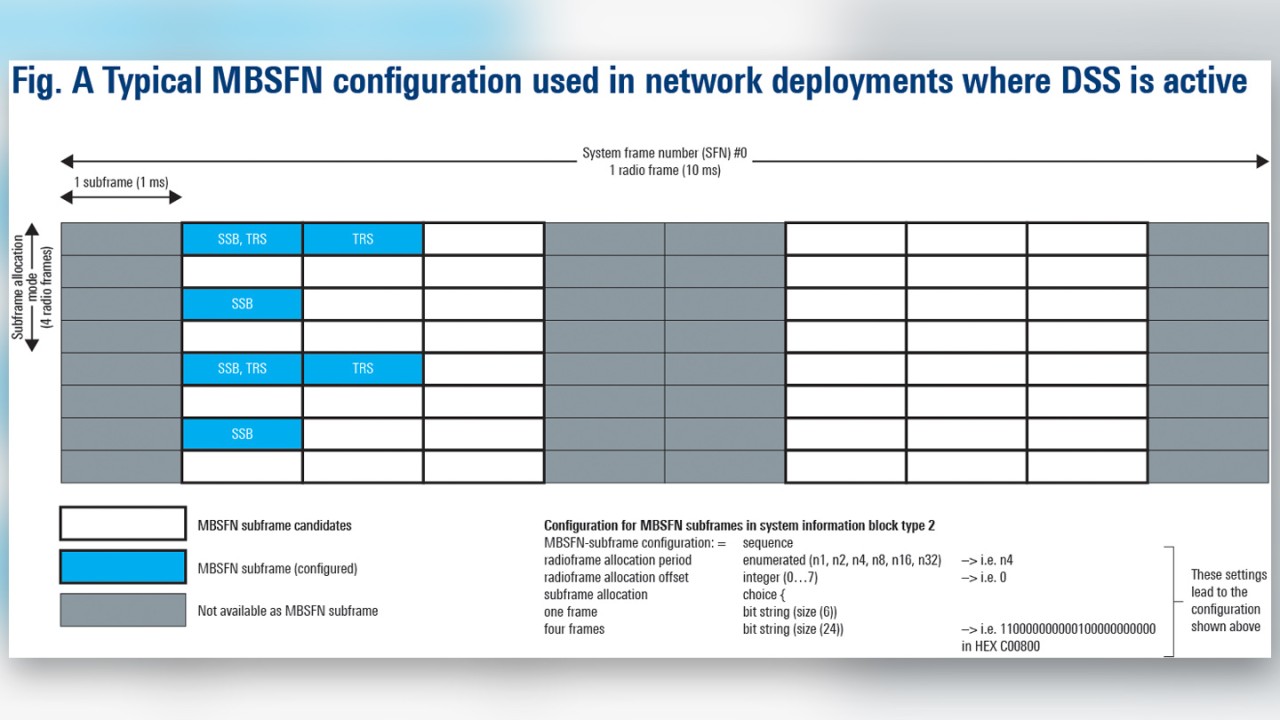Written by Andreas Roessler | October 13, 2020


The first 5G NR networks are on-air using network deployment option 3X and utilizing E-UTRA New Radio Dual Connectivity (EN-DC) with a split bearer setup. In this deployment scenario, the so-called non-standalone (NSA) mode, an LTE anchor is required to exchange control and signaling information.
In addition to LTE signaling, the anchor is also needed to configure, add, modify, and release the connection towards the 5G NR Radio Access Network (RAN). In this setup, the LTE base station (eNB) takes on the role of the master cell group (MCG), where the 5G base station (gNB) becomes the secondary cell group. Both RANs connect to the existing LTE core network (Evolved Packet Core, EPC).
The need for (dynamic) spectrum sharing
Initial 5G network deployments took advantage of the underutilized unpaired spectrum (TDD) available at mid-band frequency ranges, such as 3.5 GHz. However, most of the spectrum below 6 GHz is paired spectrum (FDD) that network operators use for their 4G LTE-Advanced networks. Due to the occupation of its FDD-based spectrum assets, service providers are forced to choose between the acquisitions of new spectrum or refarm spectrum already in use. Both options are costly.
Therefore, the 5G NR standard offers the possibility of adapting it to existing LTE deployments and sharing the spectrum exclusively used by LTE. The enabling feature is called dynamic spectrum sharing (DSS), which is part of the overall mechanism that allows 5G NR and LTE to coexist while utilizing the same frequency band.
Short-term DSS enables network operators to deploy 5G NR using their lower frequency bands, typically targeting frequencies below 1 GHz. To date, this is still NSA mode and requires the combination with an LTE anchor, typically mid-band 1 GHz to 3 GHz.
Mid to long-term, the service provider can use DSS for a smooth transition towards standalone mode (SA) when using the 5G NR deployment at the lower frequency band to provide a coverage layer for 5G NR. Dependent on the region and the network operator’s 5G deployment strategy, the vast commercialization of DSS is expected late 2020 to mid-2021.
The awakening of MBSFN
As in every wireless communication standard, the receiver needs to synchronize to the signal transmitted in the downlink. 5G NR is no different and uses synchronization signal blocks (SSB) for that purpose. When sharing the spectrum with LTE, there needs to be the possibility to transmit these SSBs. Therefore, LTE configures Multimedia Broadcast Single Frequency Network (MBSFN) subframes to allow the transmission of 5G NR’s SSBs periodically.
Six out of ten subframes forming the LTE radio frame can be configured by the network to become MBSFN subframes. Based on the standard, this could be subframes #1, #2, #3 and #6, #7, and #8. The LTE network broadcasts the applied configuration with system information block type 2 (SIB2). A standard LTE terminal would read in the MBSFN configuration from SIB2 and ignore the subframes configured for broadcast.
Figure A shows an example of the MBSFN configuration in a commercially deployed LTE network that uses DSS. The LTE network configures the allocation mode to be four radio frames, which means the given configuration repeats across a total of 40 subframes.
Three of these 40 subframes are MBSFN, or in other words, the LTE system capacity is reduced by 7.5% as the LTE network can no longer use these subframes for standard data transmissions. However, they can now be used to carry 5G signals and channels.


Figure A: MBSFN subframe configuration in SIB type 2
DSS initially aims at low-band deployments with carrier frequencies below 3 GHz, which results in a maximum of four SSB indices transmitted. The general guideline conveys the transmission of these four SSBs to the first half-frame [5 ms] of a radio frame. The mapping principle depends on the physical layer numerology.
For initial DSS deployments, 5G NR operates at the same subcarrier spacing as LTE; that is 15 kHz. For a subcarrier spacing of 15 kHz and carrier frequency below 3 GHz, the start symbols for mapping the four SSB indices are symbols #2, #8, #16, and #22. The first subframe within an LTE radio frame that is an MBSFN subframe candidate is subframe #1.
Due to the SBB mapping principles for 15 kHz subcarrier spacing, known as Case A, SSB indices #0 and #1 cannot be transmitted, as their mapping occurs in LTE subframe #0. That leaves SSB indices #2 and #3 as their mapping occurs in symbols 16 and 22. The default transmission periodicity for SSBs is 20 ms. Thus, an MBSFN subframe is required every 20 ms, which is fulfilled in the above example.
Nonetheless, in a real deployment scenario, the network sends only one SSB index. The reason is hardware-related. Leading network equipment providers claim to enable DSS by a simple software update. However, the antenna configuration of already deployed hardware does not necessarily support beamforming; it is even more unlikely for equipment that uses low-band spectrum.
DSS needs for MBSFN subframes
That means creating several coverage beams, where each beam carries an SSB index directed to a specific area of the serving cell, is not feasible at all. In the above example configuration, the transmitted SSB index is #2. Figure B gives a detailed mapping of 5G NR signals and channels within an MBSFN subframe.


Figure B: 5G NR transmission in LTE MBSFN subframes
As shown above, an MBSFN subframe is not empty. There is a non-MBSFN region defined that can be one or two OFDM symbols long, dependent on the overall available signal bandwidth. This region carries the required control channels for LTE, such as physical hybrid ARQ channel (PHICH), physical control format indicator channel (PCFICH), and the physical downlink control channel (PDCCH), including LTE’s cell-specific reference signals (LTE CRS).
Therefore, any 5G NR transmission can only start at OFDM symbols #1 or #2 within an MBSFN subframe. The second OFDM symbol (symbol #1) in the slot carries the CORESET, and the initial symbol l0 for the first transmission of the demodulation reference signal for the data channel (PDSCH DMRS) is the fourth symbol (symbol #3). The support of mobility requires the transmission of an additional symbol for the demodulation signal. Based on the definitions in the standard, this is the twelfth symbol (symbol #11).
Figure B shows the position of SSB index #2 and #3, but again only index two is transmitted. That has to do with the second signal component that requires the availability of MBSFN subframes: tracking reference signals (TRS). Index #3 would collide with the mapping of these 5G signal components. As there are no cell-specific reference signals in 5G as there are in LTE, the device maintains synchronization based on channel state information reference signals (CSI-RS) configured for time-frequency tracking.
The standard requires CSI-RS transmission over two consecutive slots, which corresponds to two consecutive subframes when the subcarrier spacing is 15 kHz. The second requirement is that two resources (= symbols) within the slot are available to transmit these particular CSI-RS configurations.
These two resources could be symbols {4, 8}, {5, 9} or {6, 10}, where the latter is the mapping that avoids collision with SSB transmission if SSB index #2 is transmitted. The periodicity for TRS as CSI-RS is flexible. However, 40 ms provides adequate accuracy and results in the requirement of having two MBSFN subframes available every 40 ms, which the network enables with the MBSFN configuration shown in figure A.
Enabling 5G NR in standard LTE subframes
Transmitting 5G NR in three out of forty subframes (see figure A) does not provide any substantial capacity for any 5G NR deployment. To overcome this situation, dynamic spectrum sharing (DSS) enables the transmission of 5G NR in standard LTE subframes not configured for MBSFN. In standard LTE subframes, there are still signal components that need to be avoided by any 5G NR transmission, even if the scheduler in the LTE base station does not intend to use this particular subframe for data transmission.
What are the challenges in avoiding these particular signal components, and what options are there for operators who want to enable 5G NR in standard LTE subframes? And, where is the “dynamic” in spectrum sharing?
Stay tuned for part 2 of our DSS article series and learn about the solution defined by the 5G NR standard for operators to overcome these challenges.
Read more about dynamic spectrum sharing in our article series:
DSS: Enabling 5G NR in standard LTE subframes (part 2)
DSS: Measurement aspects of testing LTE and 5G networks (part 3)
Measurement examples of live 5G mobile networks that support DSS (part 4)






